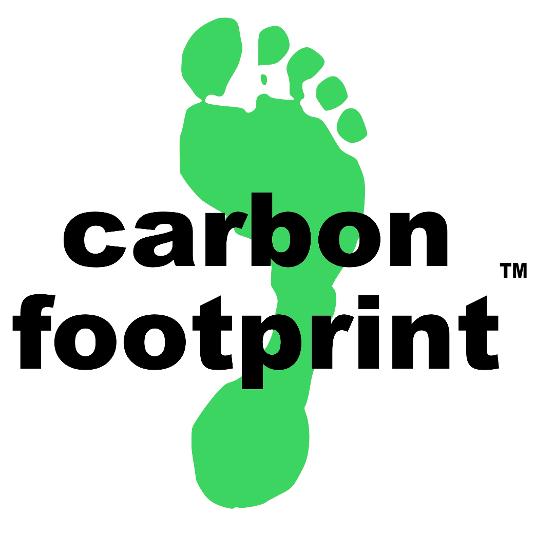South Africa
FROM Table Mountain to the City of Gold
Cape Town to Johannesburg
March 2027
(dates TBC)
14 days/13 nights
£TBC
* * * * *
Includes 3 National Parks and 4 World Heritage Sites
Exclusive small group tour, number of participants : 8-11
Includes bed and breakfast accommodation, transportation, entrance fees and geological guiding. Some lunches and dinners are included (see below for details).
Prices are per person, based on 2 people sharing a room. Single supplement applies please make contact for details.
South Africa has some of the richest geological heritage on the planet, with the iconic Table Mountain, Permian fossils of the Karoo, the world's oldest and largest preserved meteor impact structure, the world's greatest goldfield, the world's most prolific fossil hominid site, the discovery site of the world's largest diamond, the world's largest reserves of chromium and platinum, and the world's best exposures of Archean rocks. Additionally its National Parks are teeming with flora and fauna and it has wonderfully friendly local people.
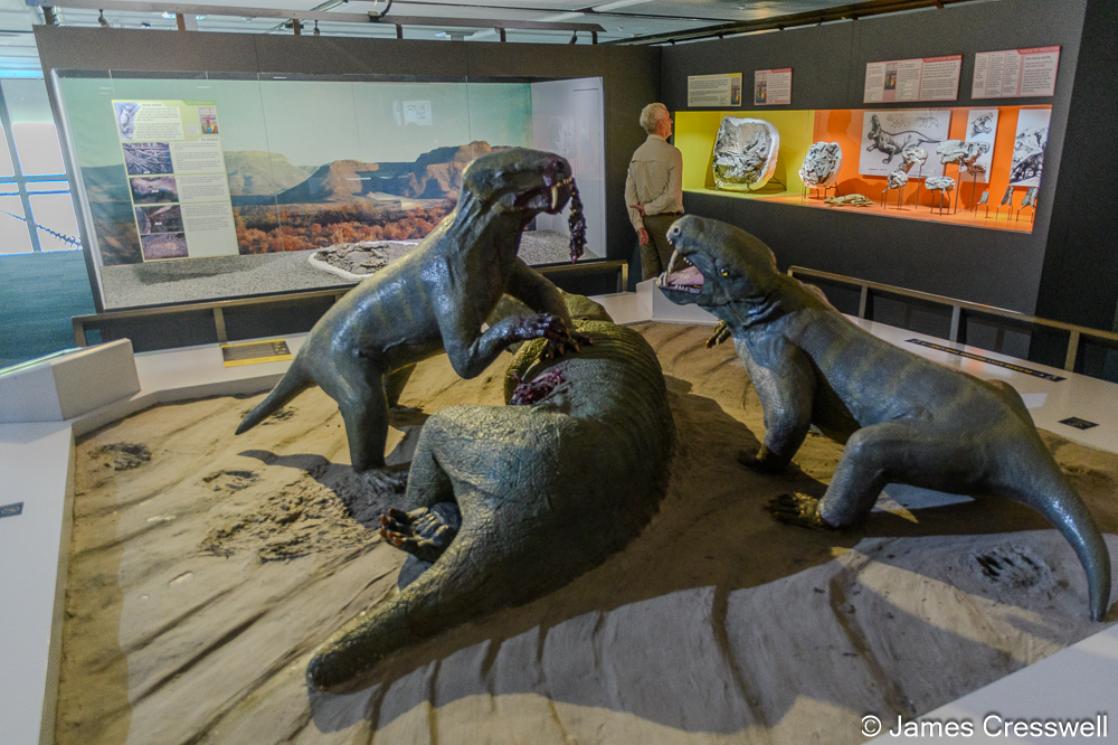
Reconstructions of Permian aged synapsids (formerly called Mammal-like reptiles) in the Iziko South African Museum.
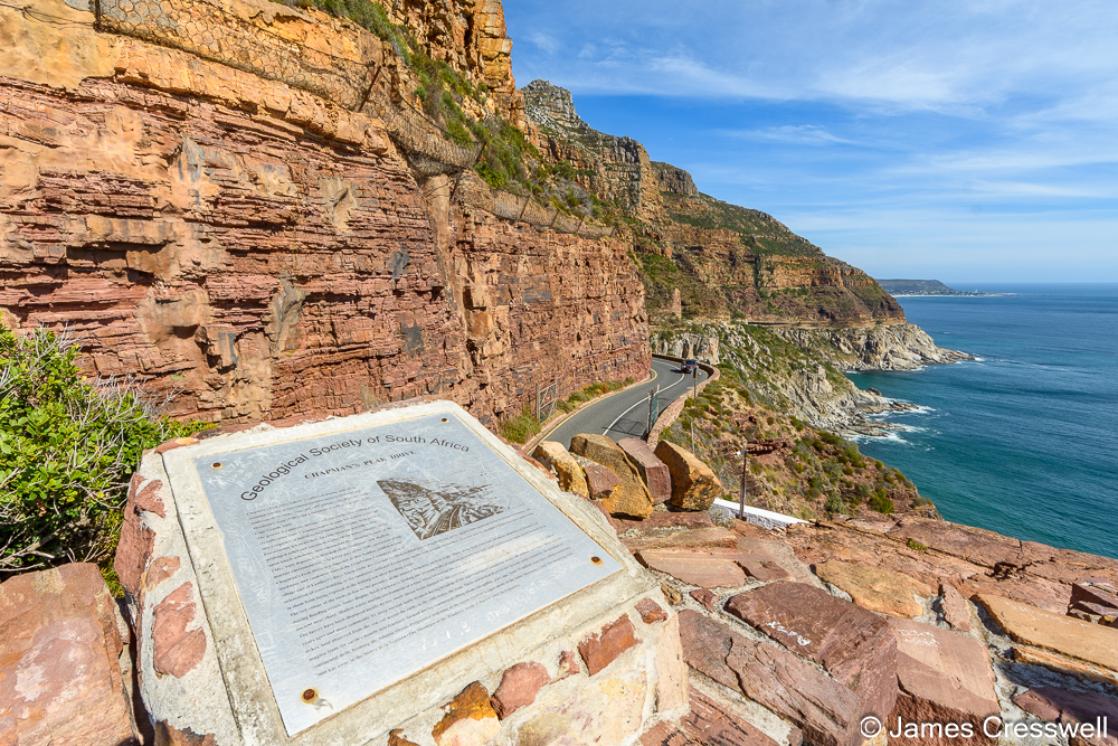
The Geological Society of South Africa’s plaque on Chapman’s Peak Drive, on the Cape Peninsula. Here the Ordovician aged sedimentary rocks of the Table Mountain Group (reddish colour) sit unconformably on the Cambrian aged Cape granite (grey colour).
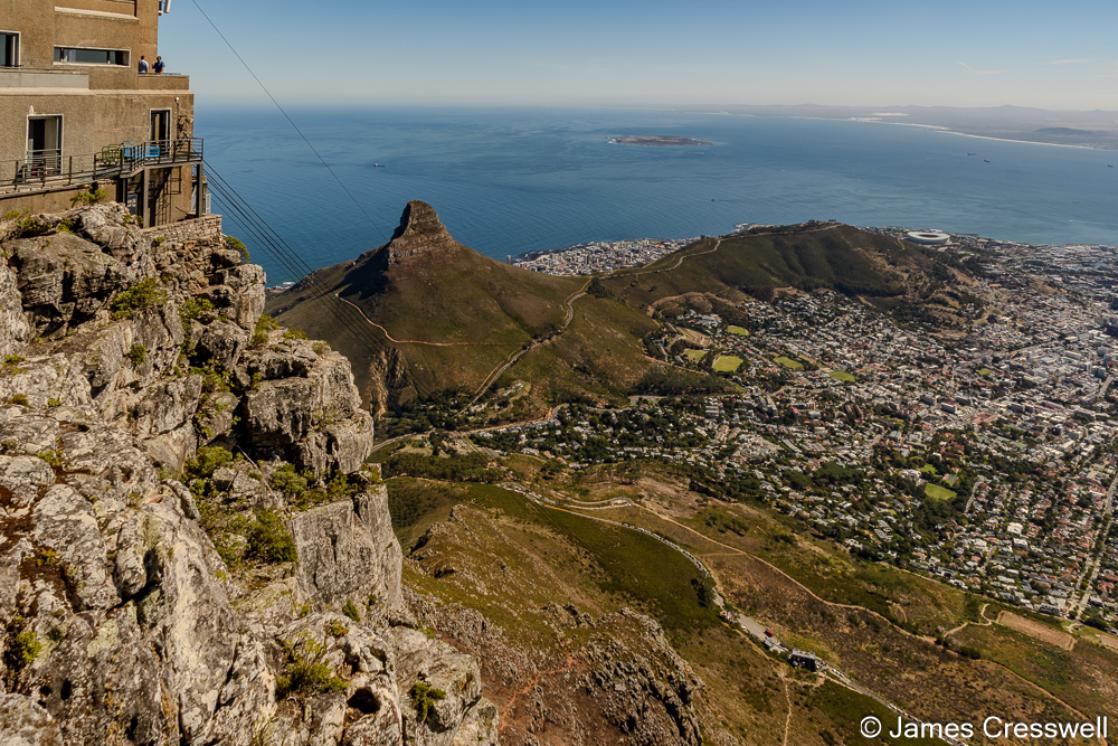
The view from the summit cable car station of Table Mountain, looking down on the city of Cape Town.
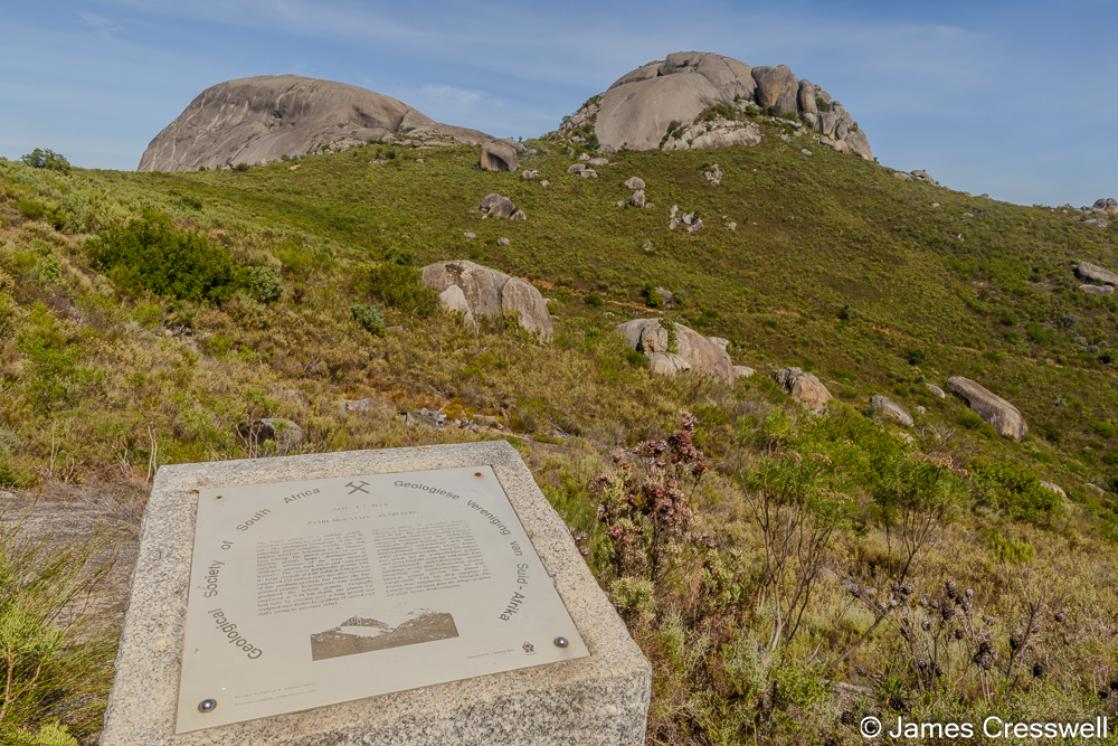
A Geological Society of South Africa plaque on Paarl Rock with Bretagne and Gordon Rocks in the background. All the rocks are part of a Cambrian aged granite pluton.
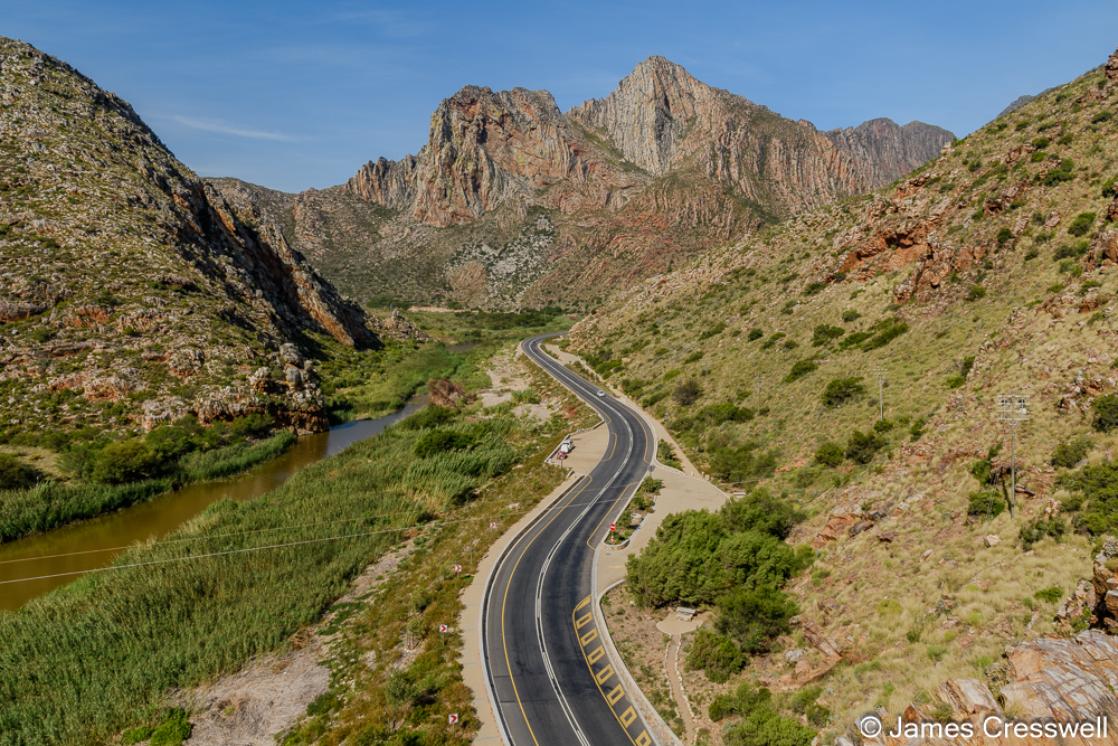
Spectacularly folded Ordovician aged sedimentary rocks of the Table Mountain Group at Cogmans Kloof in the Cape Fold Mountains.
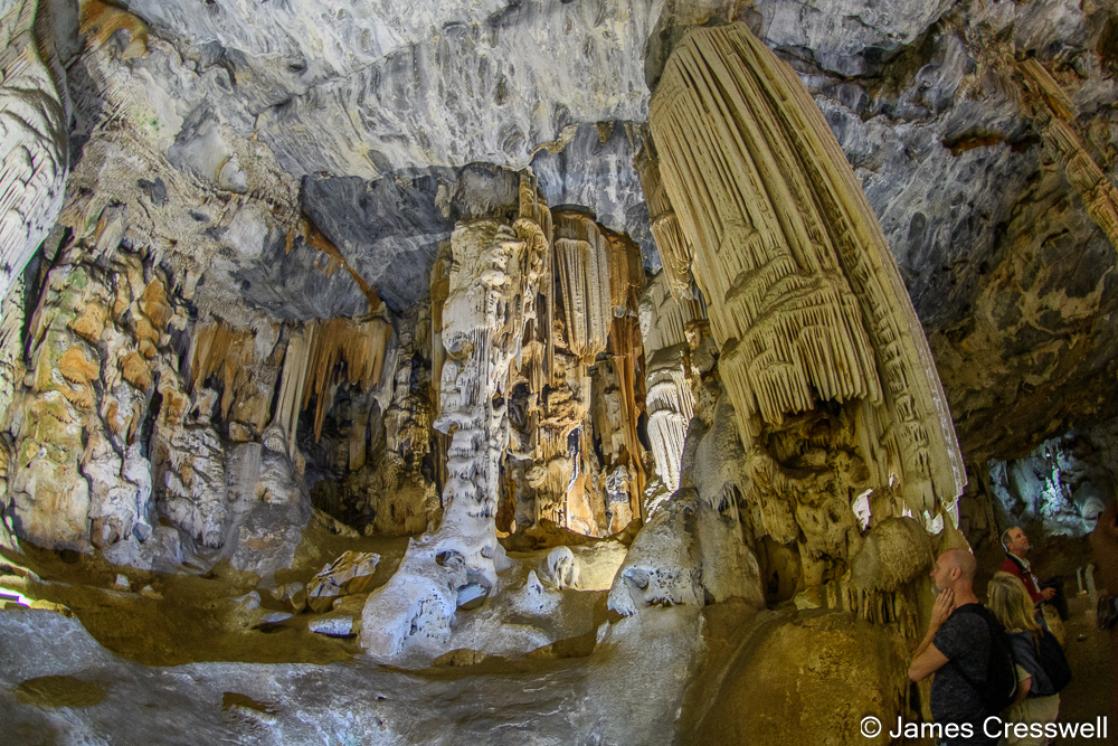
Inside Cango Caves. These spectacular caves are cut into Ediacaran aged limestone and are South Africa’s finest show caves.
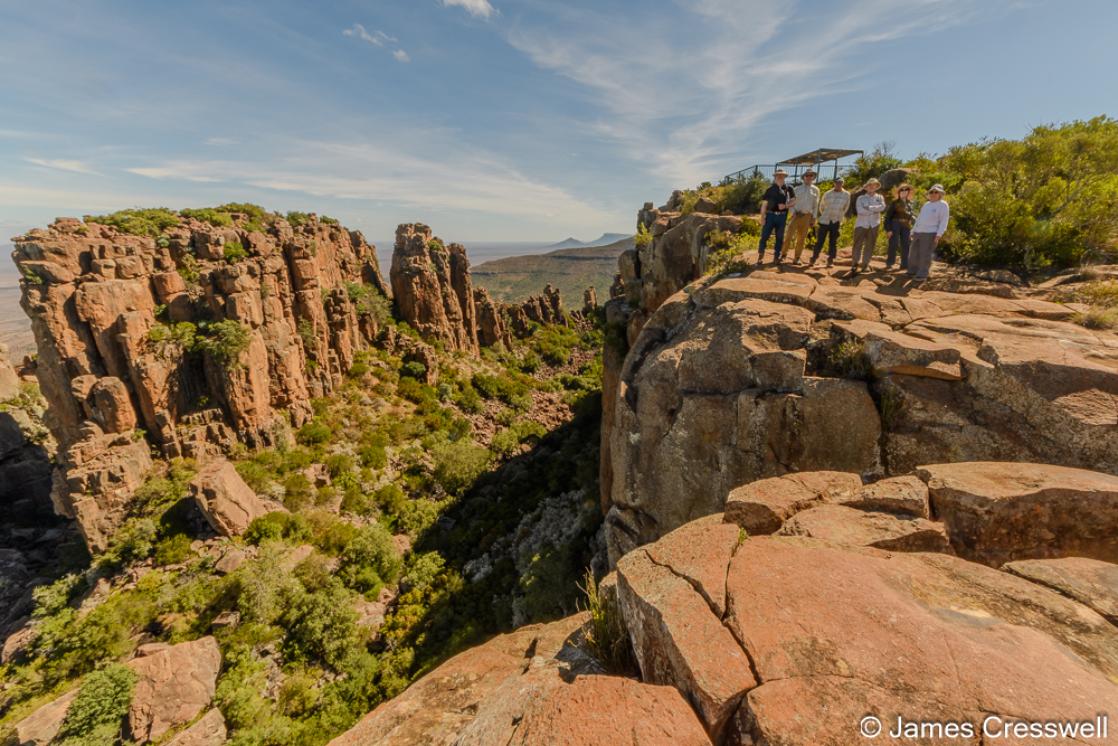
The Valley of Desolation in the Camdeboo National Park near Graaff-Reinet. The group is standing on a Lower Jurassic aged dolerite sill that intrudes Permian aged sedimentary rocks and forms part of the Great Escarpment.
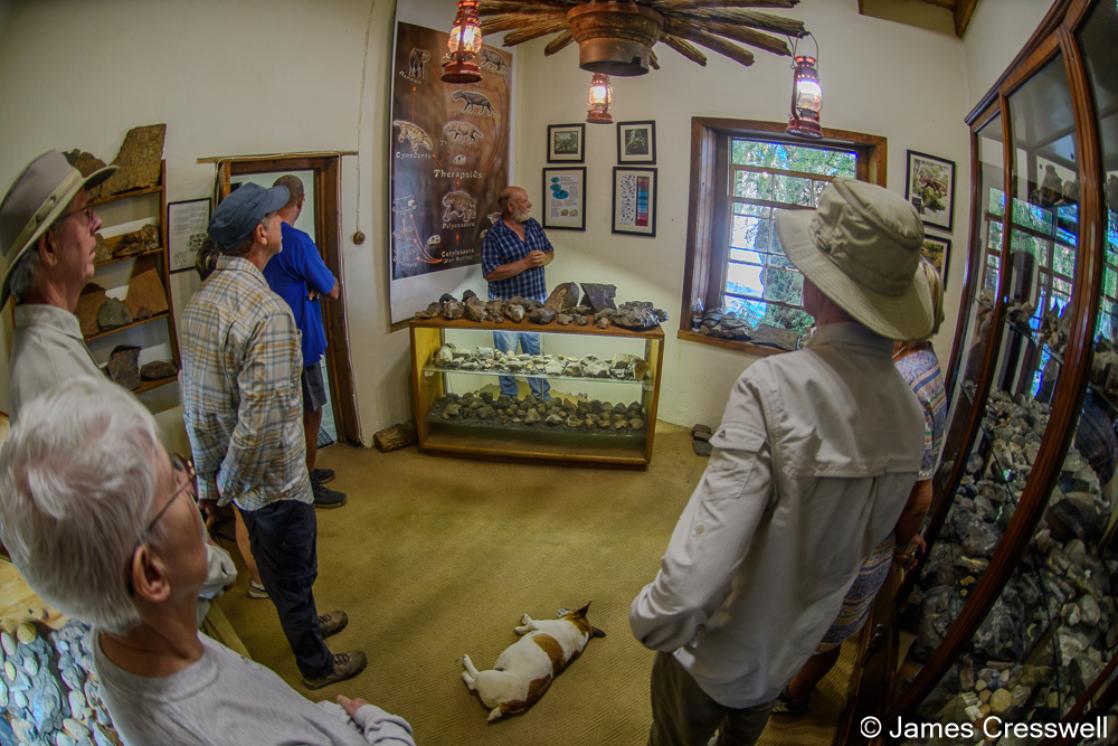
JP Steynberg gives a palaeontological talk in his private museum on Ganora Guest Farm. The museum consists of Permian fossils found on the farm.
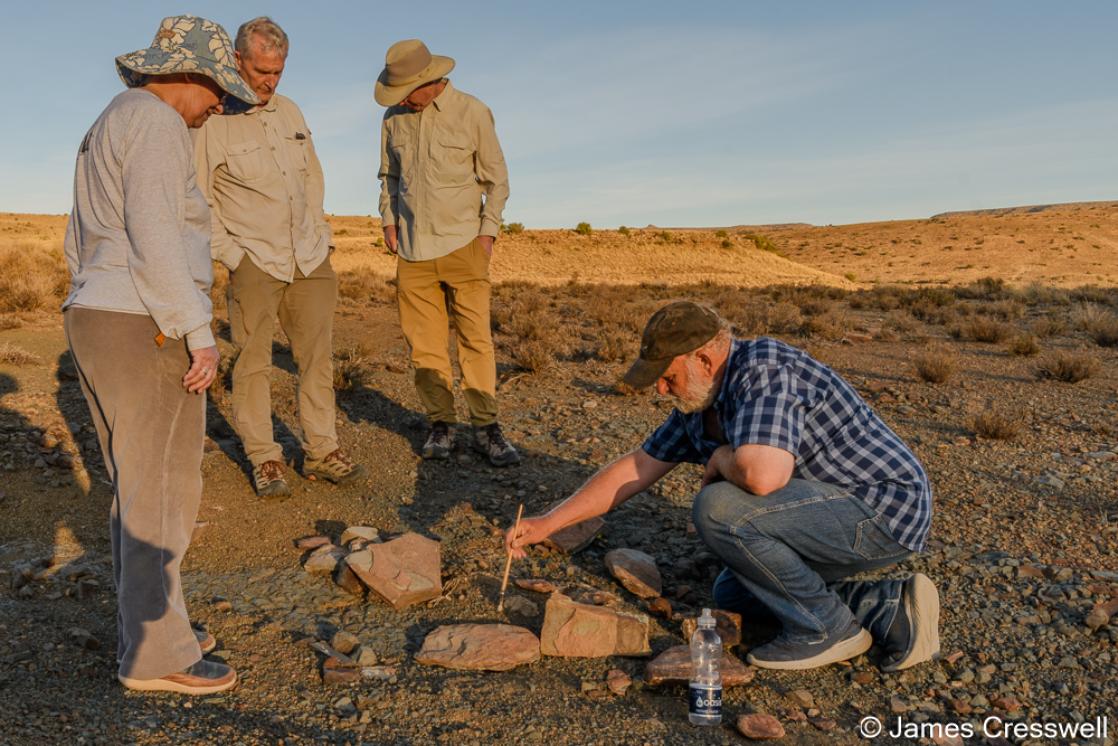
JP Steynberg takes us to his fossil discovery sites and shows up Permian fossil remains that are still lying in situ.
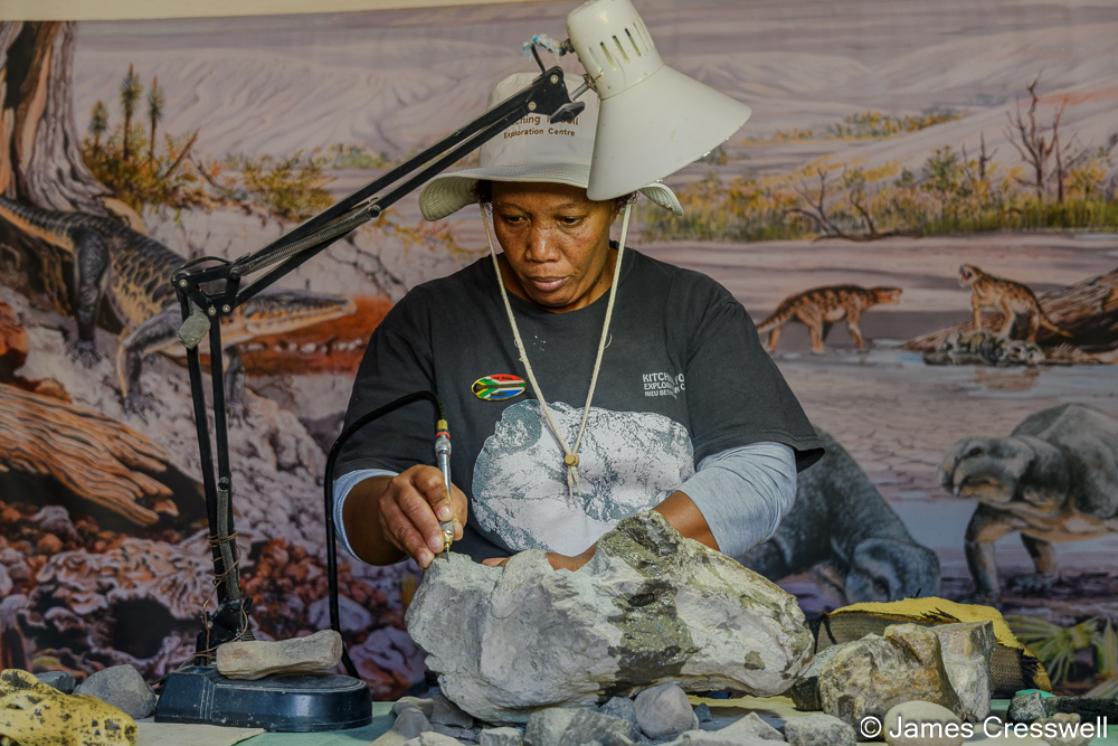
Preparation of a synapsid skull in the Kitching Fossil Exploration Centre.
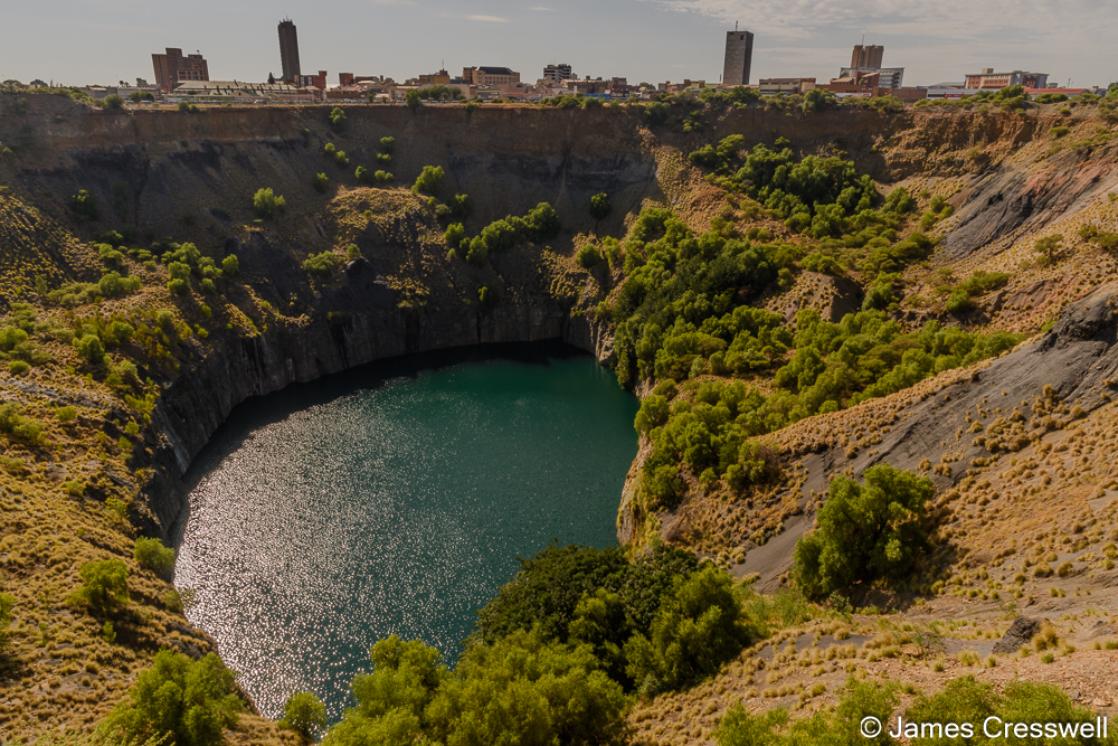
The Big Hole at Kimberley is the world’s deepest hand-dug hole. This now mined-out kimberlite pipe produced over 14.5 million carats of diamonds.
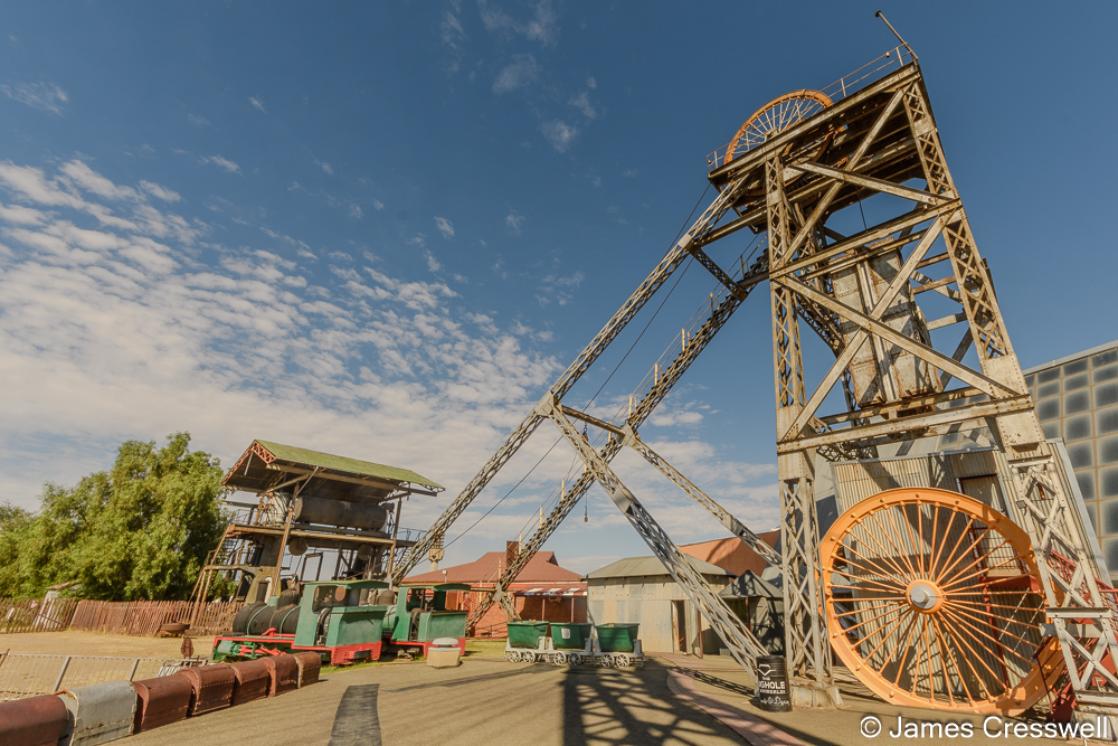
Head gear to access the underground shafts at Kimberley Big Hole diamond mine.
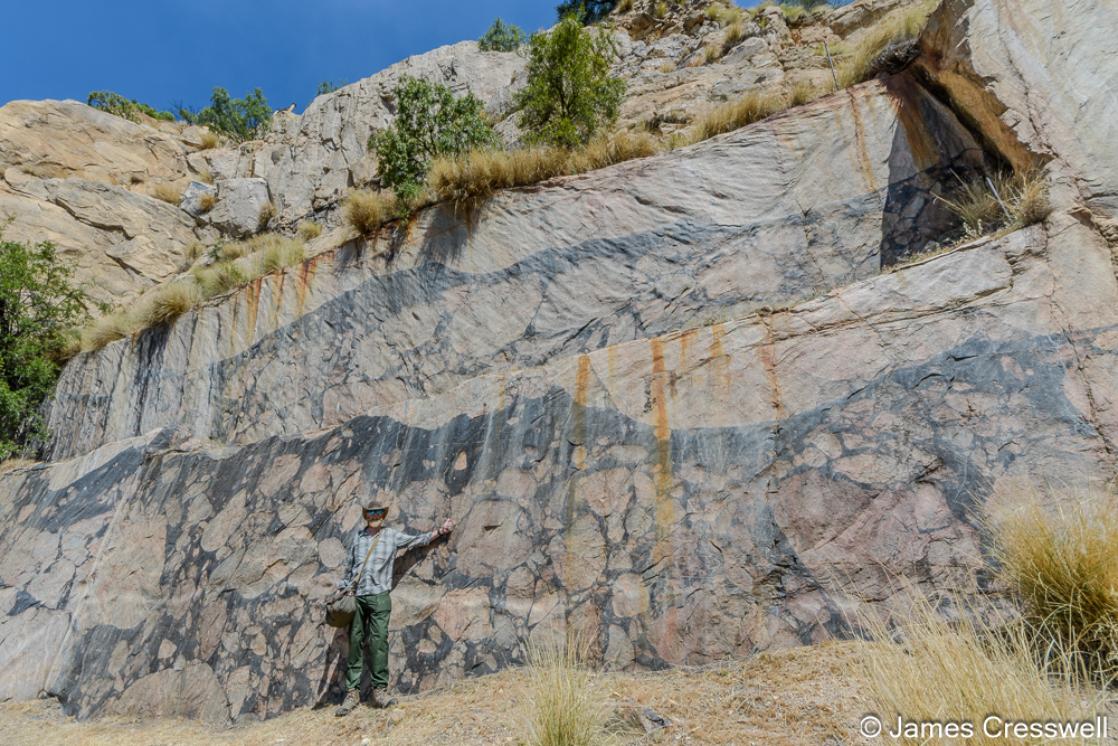
James at Leeukop quarry, the dark material is glassy pseudotachylite, which completely, melted due to friction caused by the Vredefort meteor impact.
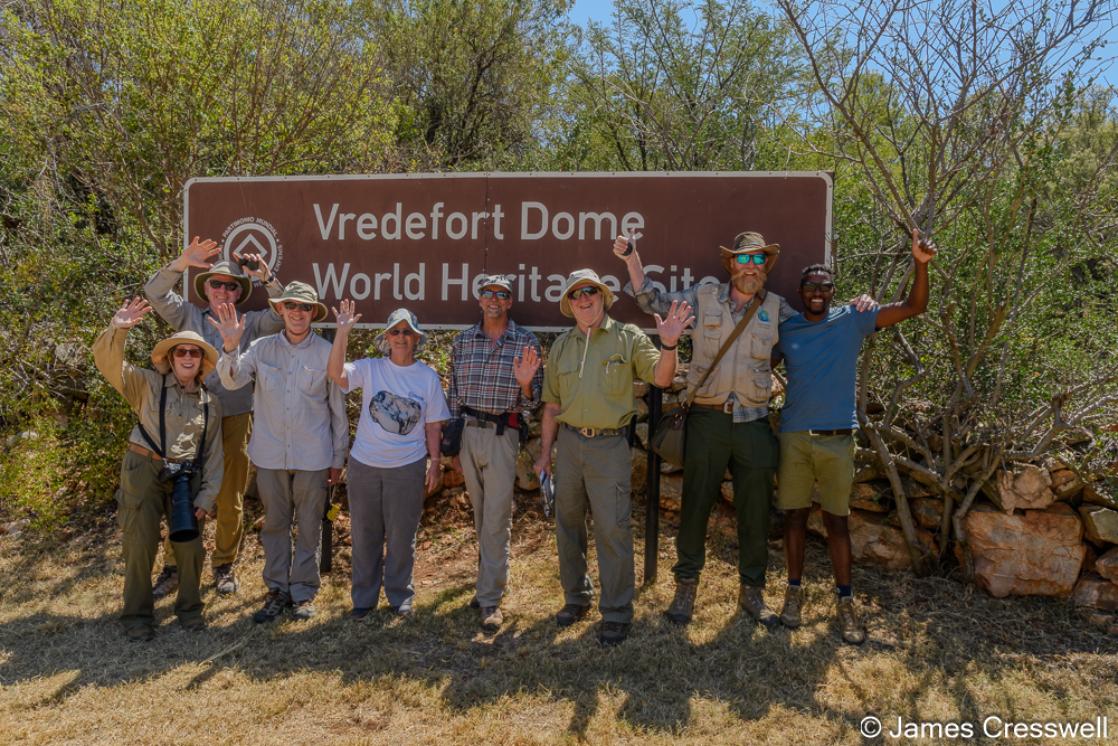
The GeoWorld Travel group in the Vredefort Dome World Heritage Site.
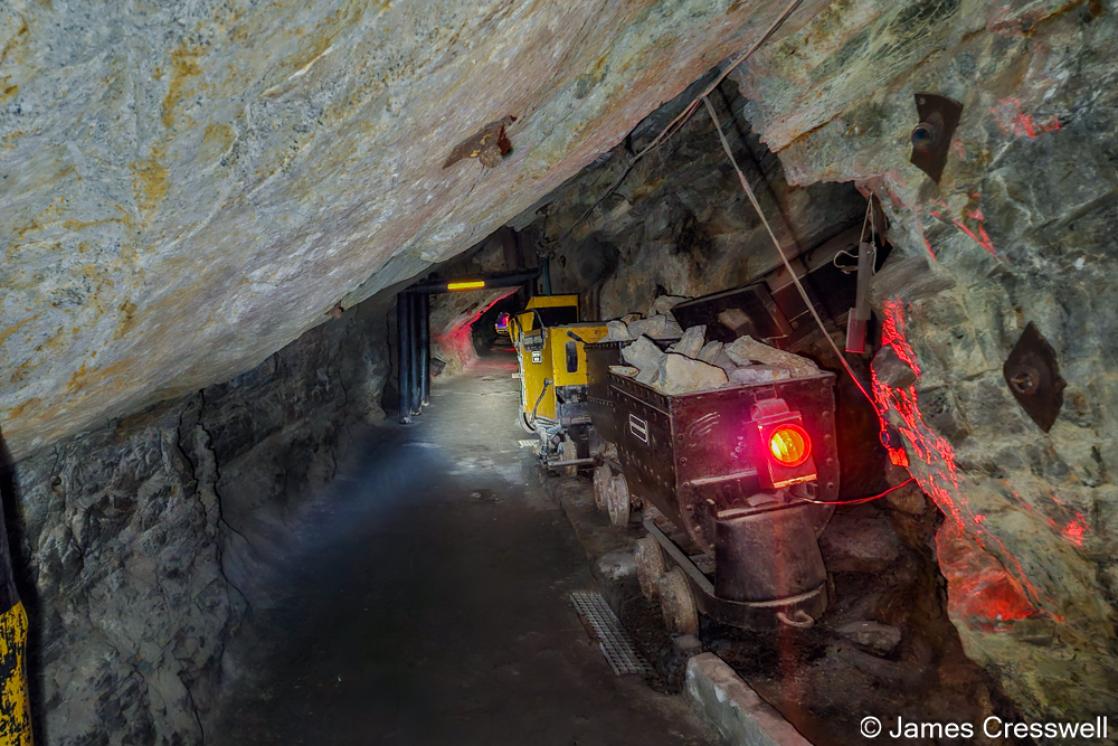
Inside Level 2 of Shaft No.14, Crown Mines, Johannesburg. The strata are dipping at 35 degrees to the south due to the Vredefort Meteor Impact. The gold mined from this level was in the Kimberley Reef Conglomerate.
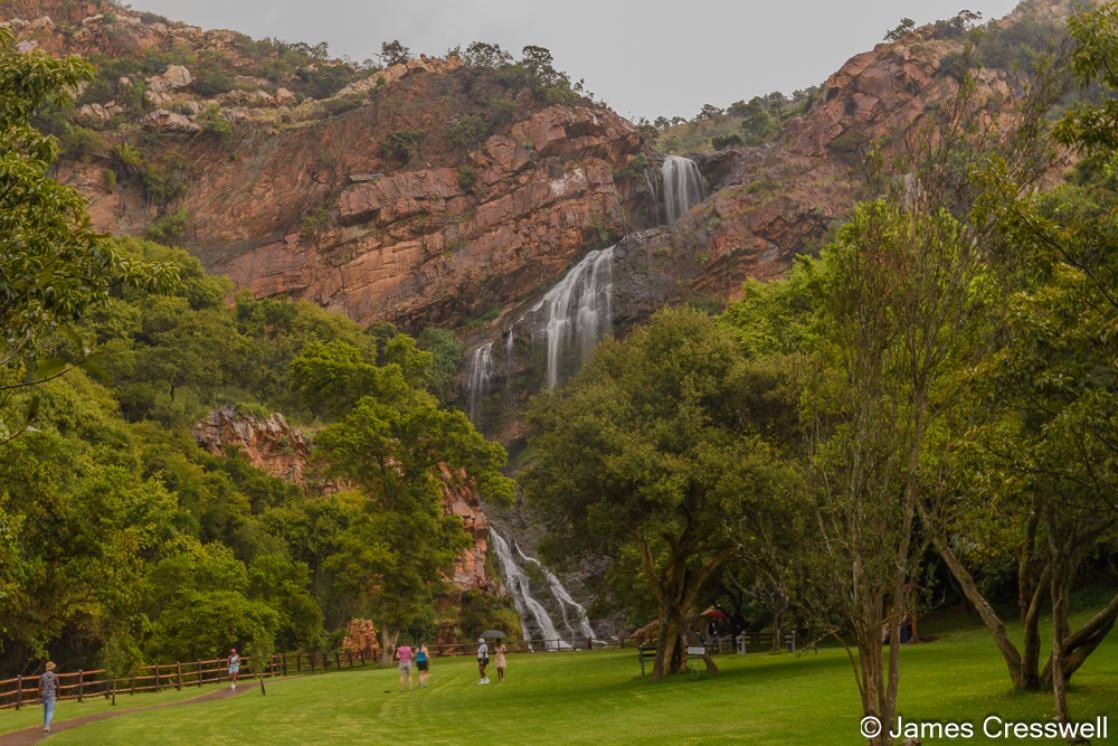
Witpoortjie Falls in the Walter Sisulu National Botanical Garden, near Johannesburg. Here the Crocodile River flows over the Witwatersrand Ridge.
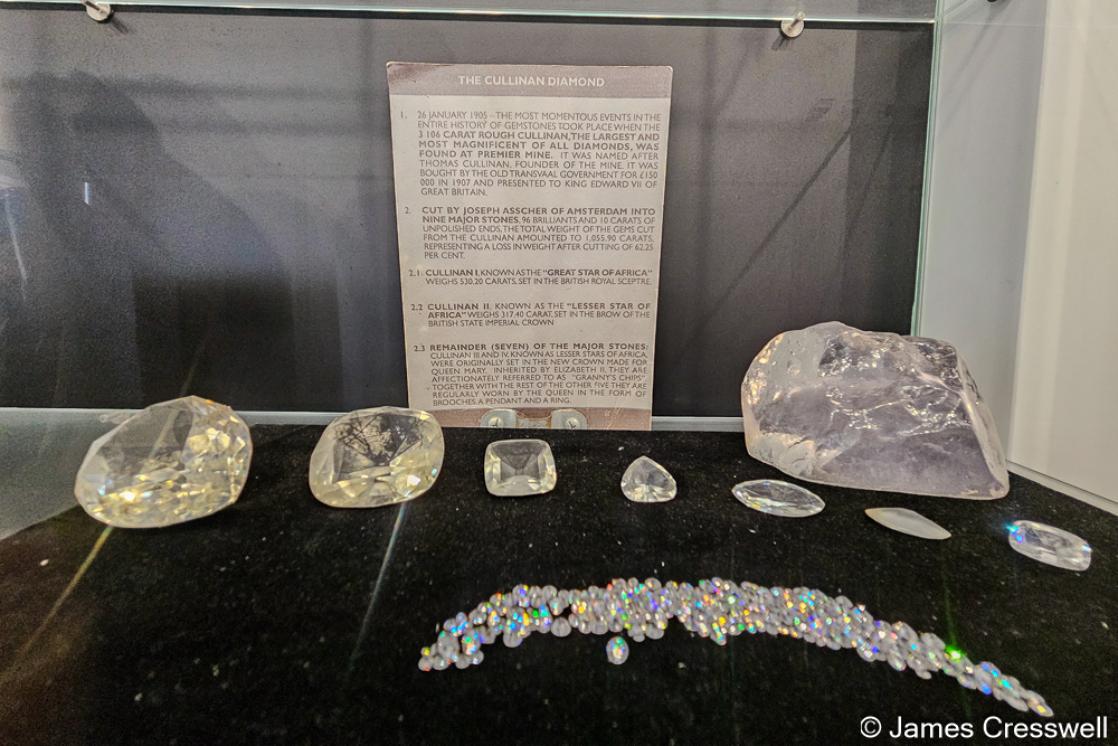
The Cullinan Diamond Mine, source of the world's largest diamond (317 carats/63g) which is set in the front of theImperial State Crown in the Crown Jewels of the United Kingdom.
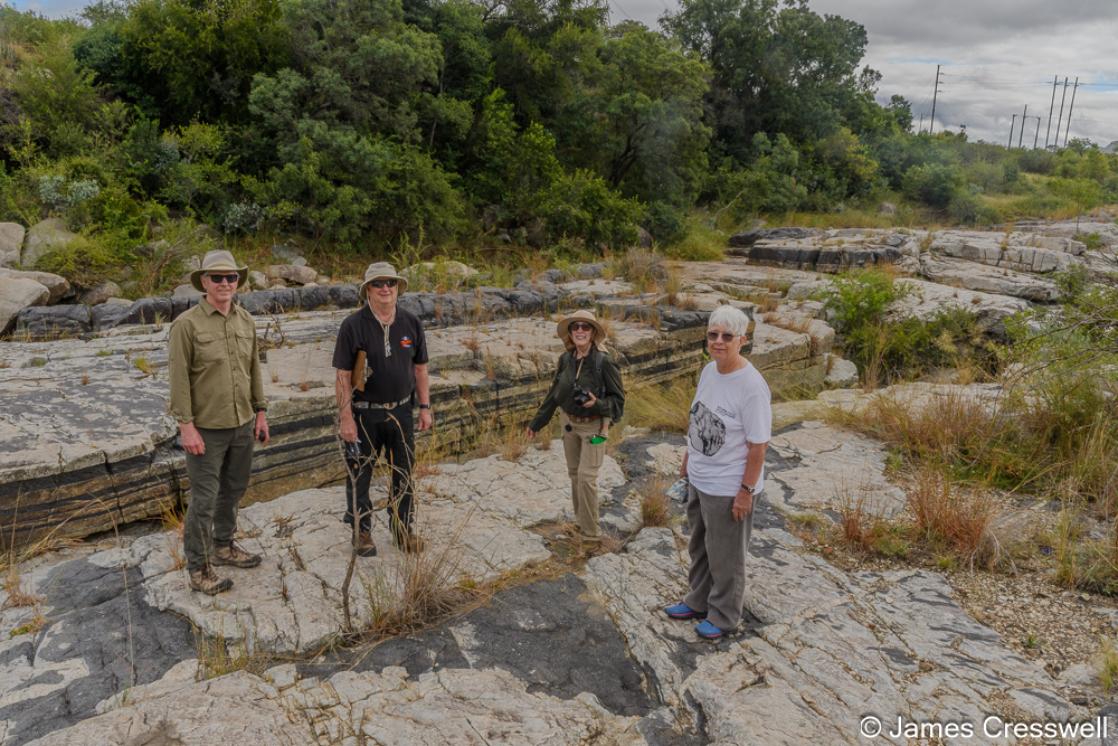
The group at the Dwars River Chromite National Monument, in the Bushveld Complex showing the extremely rare association of dark chromite layers within light anorthosite layers.
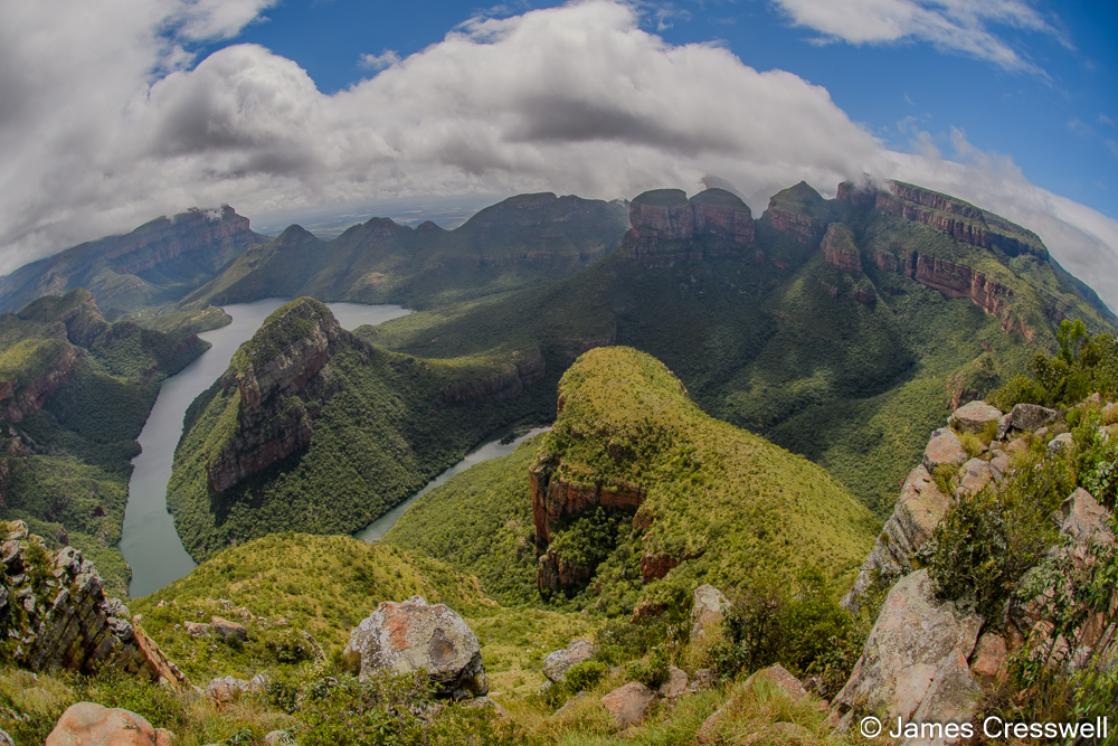
Blyde River Canyon seen from the Three Rondavels viewpoint, on the Drakensberg, part of the Great Escarpment.
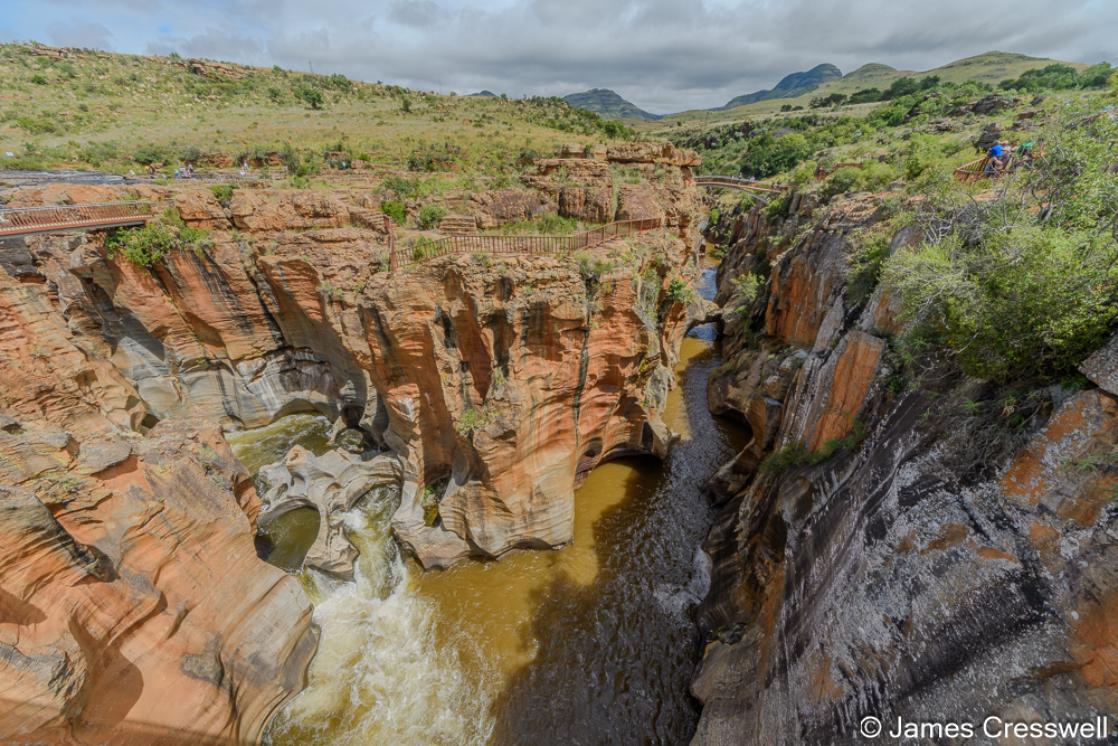
Bourke’s Luck Potholes, over millions of years, swirling water has scoured out deep cylindrical cavities in the hard bedrock. The place is named after Thomas Bourke whomade a lucky gold strike here in the 1880s.
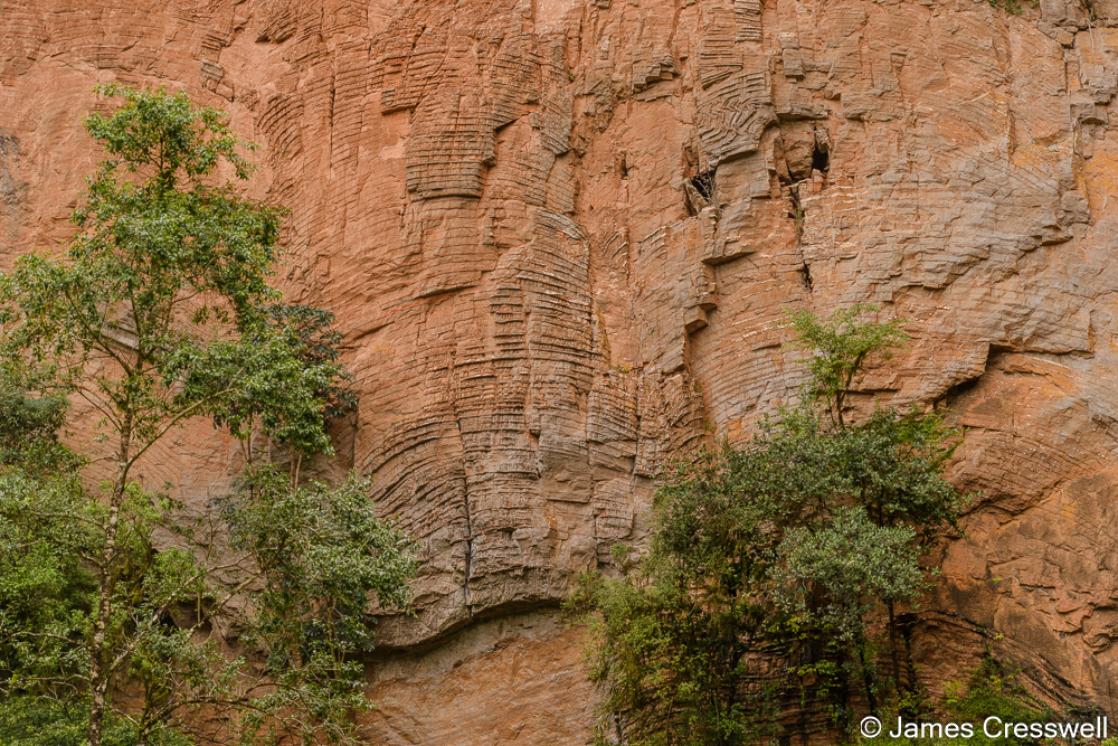
Giant domal stromatolites in the Malmani dolomite at Lone Creek Falls.
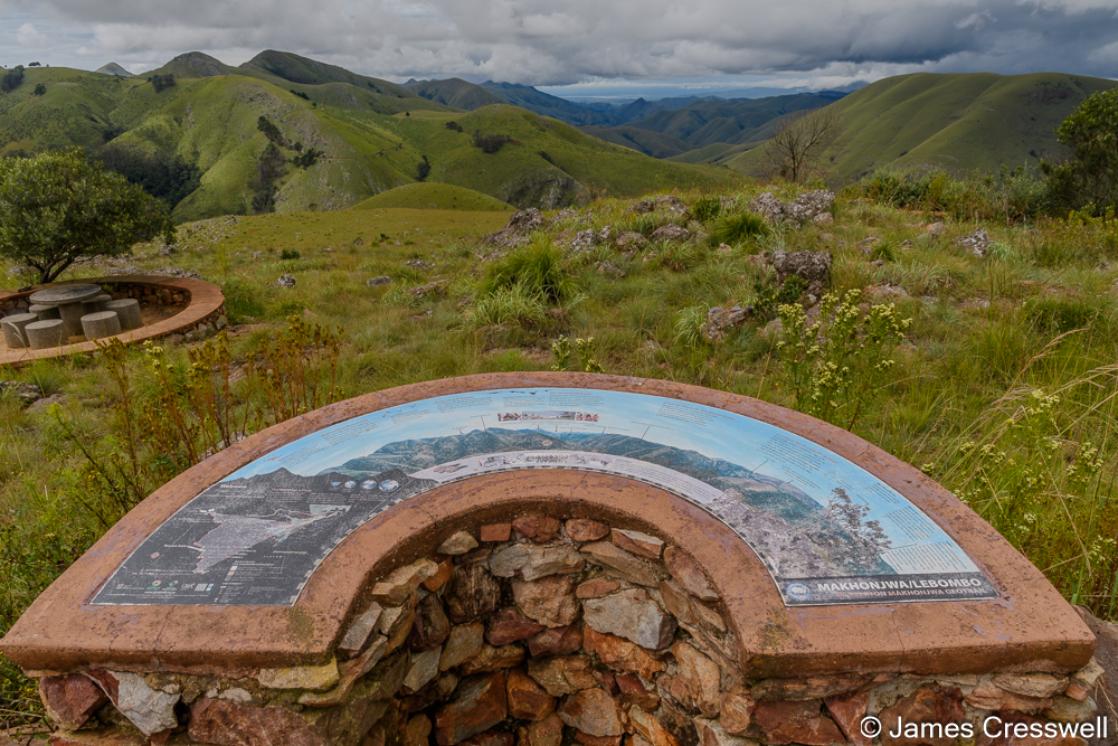
The scenery on the Barberton Makhonjwa GeoTrail in the Barberton Makhonjwa Mountains World Heritage Site.
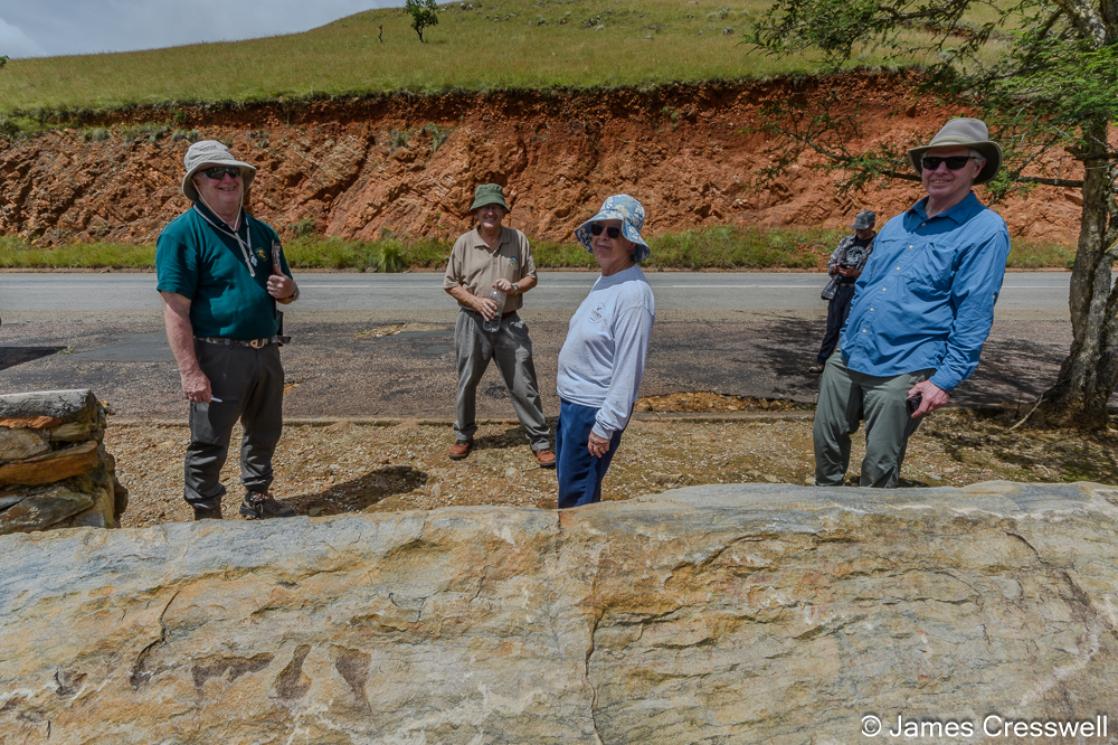
The thin black lines in the rock are the earliest evidence of life on Earth visible to the naked eye! They are remnants of 3.2 billion year old algal mats, seen on the Barberton Makhonjwa GeoTrail.
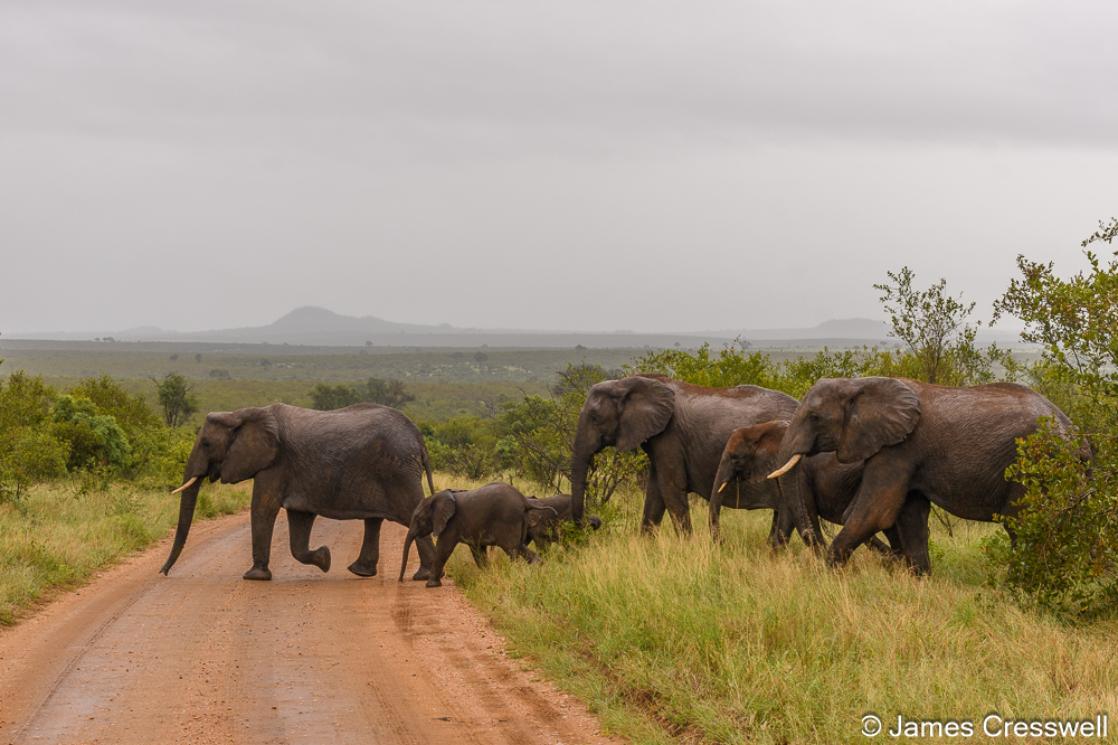
A herd of African elephants cross the road in Kruger National Park.
ITINERARY
Day 1: Arrival in Cape Town and the Iziko South African Museum. You will be met at Cape Town Airport and transferred to the hotel. Most flights from Europe or North America are overnight flights arriving in Cape Town early in the morning. After a rest in your hotel room there is time for an optional late afternoon visit the Iziko South African Museum which has excellent displays of Permian and Triassic Karoo fossils. Transport to and from the museum will be provided.
Day 2: Table Mountain National Park and World Heritage Site. Our first full touring day is spent within the Cape Town area and all the stops, except the first one, are inside Table Mountain National Park and Cape Floral Region Protected Areas UNESCO World Heritage Site. The first stop, not far from Cape Town’s waterfront, is the Sea Point contact, where Cambrian aged granites are seen intruding into Ediacaran aged shales. The outcrop, visited by Charles Darwin in 1836 on his around the world voyage on HMS Beagle, helped geologists reach an understanding that igneous rocks were originally molten and could be intruded into other rocks. The next stop is a viewpoint on the spectacular Chapman’s Peak Drive, where a Geological Society of South Africa plaque explains how Ordovician aged sedimentary rocks of the Table Mountain Group sit unconformably on the Cambrian aged Cape granite. Chapman’s Peak is 600m high and drops to the sea over a horizontal distance of less than 500m. This stop is followed by the famous Boulders Beach on the Cape Peninsula where there are boulders of Cambrian aged Cape Granite, as well as the ever-popular colony of African Penguins. After a picnic lunch we head to the Table Mountain cable car and ride it to its upper station. On top of Table Mountain, we walk around and get spectacular views of Cape Town and the Cape Peninsula. We can also view the Ordovician aged sandstone that the mountain is made from. Walking on Table Mountain is also a botanical treat. Table Mountain National Park is one of the thirteen protected areas that makes up the Cape Floral Region Protected Areas UNESCO World Heritage Site which covers just 0.5% of South Africa’s landmass yet contains 20% of all of Africa’s flora. At the end of the day we have a special welcome meal at Gold African Restaurant before returning to our Cape Town hotel for a second night. Please note the order of the stops today may vary depending on cloud conditions on Table Mountain.
Day 3: The Cape Fold Mountains and Little Karoo. Today we leave the city of Cape Town behind and head into the interior of South Africa. Our first stop is Paarl Rock, which consists of spectacular bare rock domes of granite that tower over the historic town of Paarl. Paarl means ‘pearl’ in Dutch and the town was so named because the granite domes resemble pearls. The granite domes of Paarl Rock are the eroded remains of a small granite batholith which is the same age (Cambrian) as the granite seen in Cape Town. From the top of Paarl Rock, it is possible to get great views of the town and also the granite domes of Gordon’s and Bretagne Rocks. Our journey then proceeds through the stunning scenery of Boland Mountains, part of the Cape Fold Mountains, which are a series of parallel ranges that stretch for 850km around the west and south coast of South Africa. Passing through the towns of Worcester and then Ashton, with the Langeberg range to our north, we reach the spectacular Cogmans Kloof, a pass that cuts through the Langeberg. At Cogmans Kloof we stop for our picnic lunch and at the same time, to observe the spectacular folding in the rocks. The rocks are Ordovician aged quartzites, part of the same Table Mountain Group we saw in Cape Town. The best view of the folded rocks is had by climbing up to the English Fort that was built by the British in the Anglo-Boer War. On the other side of Cogmans Kloof is the town of Montagu, and the start of the Little Karoo, an intermontane plateau that lies between the Langeberg and Swartberg ranges of the Cape Fold Mountains. We stop in Montagu to visit its museum where the first fossils ever found in South Africa are displayed. They are Devonian aged shells and were found in 1830. Our drive then continues through the beautiful Little Karoo with mountains each side passing through the towns of Barrydale, Ladismith and Calitzdorp. Along the route we make a couple of short stops to discuss the scenery, as well as a café stop, before arriving in Oudtshoorn where we spend the night.
Day 4: Cango Caves, the Swartberg Mountains World Heritage Site. Our first stop of the day is the fantastic Cango Caves. They are South Africa’s finest show caves and one of the country’s best-known natural wonders. The caves were discovered in 1790 and have been dissolved out of Ediacaran aged dolomite. After the caves we have two short roadside stops before reaching the Meiringspoort Pass which is inside the Swartberg Nature Reserve which is part of the Cape Floral Region World Heritage Site and is considered by many to be South Africa’s loveliest road pass. Here we stop for a picnic lunch and see spectacular folding in the Table Mountain Group quartzites before taking a short hike to the Great Waterfall, where it is possible to have a swim in the natural pools. We then retrace our route to the town of De Rust and drive through the eastern portion of the Little Karoo with two short roadside stops before we start crossing the flat plains of the Great Karoo to reach the town of Aberdeen which is in the Eastern Cape province. In Aberdeen we have a café break before proceeding on to Graaff-Reinet where we spend the next two nights.
Day 5: Permian aged Karoo fossils in and around Nieu-Bethesda. We start the day with a visit to the Camdeboo National Park where we visit the incredible Valley of Desolation. This fantastic geological feature is part of southern Africa’s Great Escarpment, a major topographical feature stretching from Angola, through Namibia, around South Africa and up to Zimbabwe. It is the remnant of the stepped steep walls of rift valleys that formed during the break-up of the Gondwana super-continent during the Jurassic. The rock type here is a huge sill of Jurassic aged dolerite which intruded Permian aged sedimentary rocks during the continental break up. The sill is part of the Karoo Large Igneous province, a huge area of igneous rock that outcrops both in South Africa and Antarctica. We then make the short journey to the neighbouring Nieu-Bethesda district. Our first stop is the Ganora Farm. Here we have a tour of JP Steynberg’s private fossil museum, which is full of Permian aged synapsid fossils that he found on the farm. The plan is to also have a tour of the fossil discovery sites and rock art sites on the farm. We then proceed into the centre of Nieu-Bethesda which is only a tiny town, with gravel streets. Here we visit the Kitching Fossil Exploration Centre, which is named after internationally renowned palaeontologist Dr James Kitching. He grew up in Nieu-Bethesda and was one of South Africa’s best ‘fossil-finders’. The exploration centre is a museum with fossil exhibits and information. The museum curators will also give us a tour of the nearby riverbed where in situ fossils can still be seen, as well as demonstrating some fossil preparation for us. The day ends back in the Graaff-Reinet where we spend a second night.
Day 6: The Permian-Triassic boundary and diamond mining towns. Our first stop of the day is a visit to the Old Library Museum in Graaff-Reinet which is a National Monument. This historic building has further displays of Karoo fossils. We then start our journey up towards Kimberley in the Northern Cape. The first stop is a roadcut in the Lootsberg Pass. The rocks here are in the lowest Triassic strata, being just a few metres above the Permo-Triassic boundary. Here it is possible to see the burrows of Lystrosaurus, a herbivorous dicynodont therapsid that manged to survive the Permo-Triassic extinction event, presumably by living in burrows. We then journey on to another road up on Carlton Heights, where we can actually touch the Permo-Triassic boundary! The boundary is famous for the Permian-Triassic extinction event, the largest extinction to have occurred on our planet when 90% of species were wiped out. At the stop we see an event bed that is enriched with a fungal spike, occurring just after the great dying and the fungi were breaking down all the organic material. We then journey on having lunch on the outskirts of Colesberg, before passing through Trompsburg, the centre of South Africa’s Uranium industry. Our route then enters diamond country and we stop in Jagersfontein which had a kimberlite pipe diamond mine. The mine established in 1870 has yielded two of the ten biggest diamonds ever discovered, the Excelsior and Jubilee. It has also been established that its deep hole is the biggest hand-excavated hole in the world, slightly larger by volume than the deeper hole at Kimberley. The mine closed in 2002. We then continue to Koffiefontein where we have another break. The area was a coffee stop (hence the name) for many transport riders in the 19th century until one of the riders discovered a diamond. A diamond mine was established in 1870 and the town grew rapidly. The mine is still in operation, although ownership has changed several times. The diamonds of Koffiefontein were known to be of the "first water"; meaning of very good clarity. We then continue to Kimberley, the capital of the Northern Cape, to spend the night ready to visit its famous diamond mine the following morning.
Day 7: The Big Hole Diamond Mine, Kimberley. Our first stop this morning is the famous Big Hole Diamond Mine and museum. Kimberley is the type location of Kimberlite, the rock type that forms in diamond pipes, and also the site of the world’s biggest ever diamond rush. The chance discovery of diamonds here changed South Africa’s fortunes forever. In total, five giant mines were dug in Kimberley and the most famous, the Big Hole, was established in 1872. Its now mined-out kimberlite pipe produced over 14.5 million carats of diamonds! At the Big Hole we walk out on to the viewing platform and peer into the world’s deepest hand-dug hole, which is 175m deep. We also see the mine’s headgear, go into a replica underground shaft, view real diamonds, marvel at a cheque for £5,338,650 written by Cecil Rhodes in 1888 (which bought out all the other mine claims and established De Beers Consolidated Mines Limited), and walk around the restored and reconstructed buildings of the Old Town. We then depart Kimberley, soon entering the North West Province, and stop for lunch in the town of Christiana. After lunch we journey towards Klerksdorp, passing salt pans and the remains of diamond diggings along the way. At Klerksdorp we stop at a service station and we are now in gold mining country. Like the gold fields of Johannesburg, the Klerksdorp gold field lies within the Witwatersrand Basin, a 3-billion-year-old sedimentary basin that contains the world's largest known gold reserves. Soon after leaving the service station, we see the gold mines of Stillfontein adjacent to the road. We then continue to Parys within the Vredefort Dome UNESCO World Heritage Site where we spend the next two nights.
Day 8: The Vredefort Dome Meteor Impact Structure World Heritage Site. The whole day is spent inside the Vredefort Dome. The dome is the world’s largest and oldest recognised complex meteorite impact site. Only in the late 1990s, after years of scientific debate and study, was it finally confirmed that the large, multiple, ring-like geological structure at Vredefort was formed 2,023 million years ago by a catastrophic meteorite impact. It was, in part, declared a World Heritage Site in 2005. Most of the key geological sites are on private land so we will team up with a local guide to access them. The Leeukop Quarry is where we can see pseudotachylite breccia. This enigmatic rock is a product of the meteor impact that resulted in the rock being superheated by the friction and shock. It consists of many different sizes of rounded granite-gneiss clasts set in a dark glassy matrix of melted rock, within streaky Parys granitic gneiss. On a nearby farm, we can see Vredefort granophyre. It exists in dyke-like structures where molten rock actually flowed down rather than up! The molten rock was on the surface due to the impact but then flowed down into cracks. On the farm we can also see shatter cones. These rare, small-scale geological features with fine, radiating, cone-like (or fan-like) striations are associated exclusively with meteorite impact structures or with underground nuclear explosions. Their formation is due to the impact shockwave moving through the rock. We then get views of the collar zone of the impact and see 3-billion-year-old Witwatersrand strata upturned by the impact. We may also visit Venterskroon to see Witwatersrand conglomerates and more shatter cones at Schoemansdrift Bridge, before returning to Parys for a second night.
Day 9: Johannesburg and the Cradle of Humankind World Heritage Site. This morning, we arrive in Johannesburg the world’s greatest gold mining city. Johannesburg was established in 1886, following the discovery of gold, on what was then just a farm. Due to the extremely large gold deposits found along the Witwatersrand (the white-water ridge), within ten years, the population had grown to over 100,000 inhabitants. It now has nearly five million inhabitants and is South Africa's largest city. Our first stop is Gold Reef City, a theme park that has been built on the site of Crown Mines. Within the theme park, Shaft 14 of the gold mine is still operational and we take an underground tour where we see the Witwatersrand conglomerates that have been mined for their gold. Crown Mines Limited was the world’s first super-mine and at one time was the busiest and most profitable gold mine in the world. Peak production was in the 1930s and, when it closed down in 1977, this mine had produced over 45 million troy ounces (over 1,400,000kg) of gold from production over nearly 90 years. The shafts at Crown Mines used to extend 2,875m below the surface, however our tour only descends 75m and most of the lower levels are now flooded. After leaving the mine we make a drive-by of George Harrison Park, the site of Johannesburg’s first gold discovery. George Harrison was an Australian prospector who made the find on what was then the Langlaagte Farm. We then travel to the western fringes of the city’s built-up area to visit the wonderful Walter Sisulu National Botanical Gardens. Here we see the Witpoortjie waterfall pouring over the Witwatersrand, which means white water ridge, and it is these waterfalls that gave it its name. In the gardens there is also the Geological Display Garden, which provides a walk-through of South Africa’s geological time, showing a variety of important regional rock types, with easy-to-understand explanations, and geological ages marked on the walkway. Our final stop of the day is the Sterkfontein Caves which lie in open countryside to the west of the Johannesburg suburbs. The fossil-rich dolomite caves around Sterkfontein are the most prolific source of fossil hominids remains in the world, resulting in this unique heritage area being named the Cradle of Humankind. The area was inscribed a world heritage site in 2000. The night is spent in a country lodge, in the nearby rural area of Muldersdrift.
Day 10: The Cullinan Diamond Mine and the Bushveld Complex. The first stop of the morning is the Cullinan Diamond Mine, near Pretoria, where we take a guided tour of the surface operations and peer into its deep hole. The mine is famous for the discovery of the world's largest diamond and South Africa's largest kimberlite pipe. Cullinan’s kimberlite pipe, named Premier, is 1,200 million years old, an unusually ancient kimberlite – in fact the oldest diamond-producing kimberlite in the world. The pipe’s pre-mining surface area was 32ha and Cullinan’s resulting Big Hole is now nearly 1,000m long and 450m wide – at least four times the size of the Big Hole at Kimberley – and it continues to grow as the sidewalls collapse into the old open-pit. Since mining started from the surface in 1903 more than 350 million tons of kimberlite have been mined to produce around 120 million carats (more than 24 tons) of diamonds, and mining continues to this day. Open-pit mining ceased in 1932, having reached a maximum depth of 189m, and in 1947 a start was made on the first shafts for underground mining, now done using large-scale mechanised block-caving methods. The fist-size Cullinan Diamond was found in 1905 and is the largest gem diamond ever discovered weighing 3,106 carats (0.62kg). It was cut into nine major and 96 minor gems, the largest four are now part of the British Crown Jewels. After lunch in Cullinan we drive to the Eastern Limb of the Bushveld Complex, and stop at Magnet Heights near Ga-Mogashoa in Limpopo Province. The Bushveld Complex is by far the world’s largest layered mafic intrusion and contains the greatest concentration of mineral wealth on Earth, comprising platinum group metals, chromium, nickel, iron, titanium and vanadium. The Bushveld Complex contains vast layers of pure magnetite rock called ‘magnetitite’. At Magnet Heights, the 2m-thick Main Magnetite layer is exposed very close to the road. Our next stop is the Dwars River Chromite National Monument. This is a world-famous exposure in the Bushveld Complex showing the extremely rare association of dark chromite layers within light anorthosite layers. The area around Dwars River is the world’s main chromite producing area and we spend the night near Steelpoort.
Day 11: The Drakensberg. The Drakensberg is the name for the eastern portion of the Great Escarpment, and it stretches for more than 1000km from the Eastern Cape to near the Zimbabwe border. Our first stop on the Drakensberg is the Three Rondavels viewpoint of the Blyde River Canyon, in Mpumalanga Province. The canyon is said to be the third largest canyon on Earth and is a magnificent demonstration of deep river incision. The name 'The Three Rondavels' is due to the three rounded rock columns that resemble traditional circular African dwellings with conical thatched roofs. The rock sequence that the canyon cuts through are 2.65-billion-year-old alternating layers of softer shale and harder quartzite. The next stop Bourke’s Luck Potholes, where we see a wonderful demonstration of the erosive action of small turbulent rivers, over millions of years, swirling water has scoured out deep cylindrical cavities in the hard bedrock. The place is named after prospector Thomas Bourke who reportedly worked here in the 1880s and allegedly made a lucky gold strike. The next stop, God’s Window, is 1,730m above sea level and is a spectacular viewpoint. On a clear day you can see 100km across the Kruger National Park to the distant Lebombo Mountains bordering Mozambique. The Drakensberg has many spectacular waterfalls along its length, too many to visit with the available time, so we choose to visit the 68m high Lone Creek waterfall due to the rocks it flows over: 2.2-2.5 billion year old dolomite which contains giant domal stromatolites. The last stop of the day, Sudwala Caves, is cut into the same dolomite and we can see fossil stromatolites within the caves and we can learn about the hominid Homo habilis who inhabited the cave 1.8 million years ago. Finally, we arrive in Mbombela (formally known as Nelspruit) and check into our hotel for the final three nights of the tour.
Day 12: The Barberton Makhonjwa World Heritage Site and GeoTrail. The whole day is spent in the Barberton Makhonjwa UNESCO World Heritage Site, which contains the best-preserved examples of Archean rocks in the world. The rocks are 3.5 to 3.2 billion years old and form the so-called Barberton Greenstone Belt. They consist of sedimentary and volcanic rocks and provide key insights into the formation of the continents, and the environment in which life first appeared. Our first port of call is the excellent Barberton Museum where we see all the important rock types displayed. We then head out along the 38km long Barberton Geotrail, a tarmacked route that stretches from Barberton to the Eswatini border. On the route, which has eleven different outcrop stops with interpretation boards, we plan to be joined by a local geological expert. Highlights include 3.5-billion-year-old pillow, lavas, the oldest signs of life that can be seen with the naked eye, possible tsunami deposits, accretionary lapilli from meteor strikes and a record from the world’s oldest known tides. Barberton’s most enigmatic rock, komatiite, a type of magnesium rich lava that could only form in the hotter conditions that existed in the Archean, does not outcrop on the trail but can be seen in the Barberton Museum. After completing the Geotrail we return to our hotel in Mbombela.
Day 13: Kruger National Park. The focus of today is not geology, although the park contains lots of outcrops of Archean granite, but it is all about the wildlife. We will be collected from our hotel by an open topped game viewing vehicle very early in the morning and will arrive at the National Park entrance for dawn. The whole morning is spent on a game viewing drive, before arriving back at the hotel in the early afternoon. Kruger is one of the of the world’s largest national parks and was the first national park to be established in South Africa. It has 147 species of mammal including the big five (elephant, rhino, buffalo, lion & leopard), 507 species of birds, 114 species of reptile and huge numbers of invertebrates. We arrive back in Mbombela by mid-afternoon for a rest to before our final group dinner.
Day 14: Departure from Johannesburg. Today there are no geological stops, although numerous coal mines can be seen as we drive, with a stop for lunch, to Johannesburg. We arrive at OR Tambo International Airport by mid-afternoon. The tour ends here at the terminal buildings, alternatively you can be taken to an airport hotel for an additional night/nights. Most flights to Europe and North America fly out in the evening, and there are also numerous daily flights to Cape Town.
INCLUDED
Geological guiding from James Cresswell
Cultural guiding and transportation from Thobela Roloma
Hotel accommodation (inc breakfast)
Eight picnic lunches
Six dinners
Entrance to all attractions and National Parks (excluding Kruger)
Transfer from the airport to hotel
NOT INCLUDED
Flights to South Africa
Five lunches
Seven dinners
Kruger National Park day safari (likely to be c£80-90)
CARBON GENERATED BY THIS TOUR
